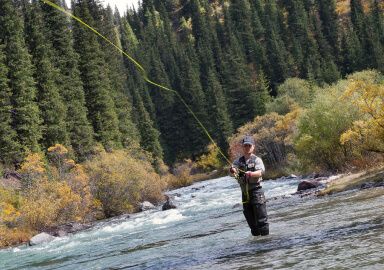Alligator Gar
Big, ferocious, and found in freshwater areas of the American South and parts of Mexico, the alligator gar is more than aptly named.
View 5 listings
5
listings
–
price starting from
2
countries
–
to the nearest trip
Where and When?
The original natural distribution of the alligator gar was the central and southern states of the USA, including the coastal areas of the Gulf of Mexico and a smallish area of Mexico reaching Veracruz. Persecution for many decades resulted in the apparent extinction in some northern areas such as Idaho and Iowa. Introductions, to control invasive carp, have further complicated the situation but large gar are now most common in the southern states in large lakes, dams and backwaters. Outside North America, alligator gar are kept in stocked ponds of “fishing resorts” on Thailand, where they are offered for sports fishing along with other big freshwater species such as Mekong catfish and arapaima.
Alligator gar usually stay within a few feet of the water surface, to ambush prey, but can be found throughout deep or shallow water. They prefer sluggish or stagnant water and are usually solitary, except when spawning. When flooding takes place and backwaters are filled during high temperatures, gar will enter the shallows where there is good cover. Males will then congregate around a female and fertilise the eggs which are bright red and poisonous. About 150 000 eggs can be produced per spawning.
About Alligator Gar
Once you've seen an alligator gar (Atracosteus spatula), you'll have no doubts why it's named so: its size, shape and life habits resemble an alligator more than a fish. This species is an important part of American fishing and other folklore and, in recent years, has morphed from being regarded as a “pest” and “trash fish” to a respected and valued member of underwater ecology and a priority target for anglers.
Alligator gar have torpedo-shaped, sturdy, elongated bodies with a short, broad head and a shorter, broad mouth. The fins are large and used for locomotion and manoeuvring. The pectoral fins are used to change direction, for reversing and for preparing to ambush prey. The three large fins at the rear - the dorsal, caudal and anal fins - are largely used for slow movement, but also to prepare for and power the rapid, strong surges that the alligator gar uses to capture prey.
They are brown to olive grey above and a lighter yellow grey below. The mouth is armed with impressive, large, sharp, pointed teeth - there being a double row in the top. The fish can grow very large, one of the largest caught being confirmed at 2.57 m. (8 ft 5 in.) and 148 kg. (327 lbs.). They are estimated to live for at least 50-70 years and possibly up to 90. They are ambush predators, feeding mostly on fish, but will take almost anything, including frogs, snakes, rodents and birds.
How to Catch?
The best way to fish for alligator gars depends on the area, circumstances, size of fish targeted and the preferences and resources of the angler. The species has created a large group of almost fanatical anglers whose principal aim in life is to catch large gar. Ordinary anglers, however, can also have good experiences and great fun targeting them. In some areas boats are essential, but bank or pier fishing, if possible, can often give greater control over a large, hooked fish. Good quality, strong and heavy tackle is essential as gar has many sharp teeth and there’s always a chance of a big fish.
While some specialists may use flies and have great fun, others spin with surface lures with success, but bait fishing is by far the most popular. Live or dead bait works and various species of fish are used. Chicken and other meats also work, but locally caught fish seems to be the best choice and the method of presentation is decided by the angler. Possibly the simplest way to fish for gar is, using a large, strong, circle hook to impale the (live or dead) bait and cast it out into a likely spot. When the fish takes the bait let a little line run out and then, gently but very firmly, lift the rod until all hell breaks loose.
Bowfishing for alligator gar is also very popular, and is a great challenge as the species have exceptionally strong scales. No matter what method you use to catch them, the alligator gar is one of the largest and strongest fighting fish in the USA and a worthy opponent. The capture of a large specimen usually results from a lot of preparation, insight, information, investment and a bit of good luck!






